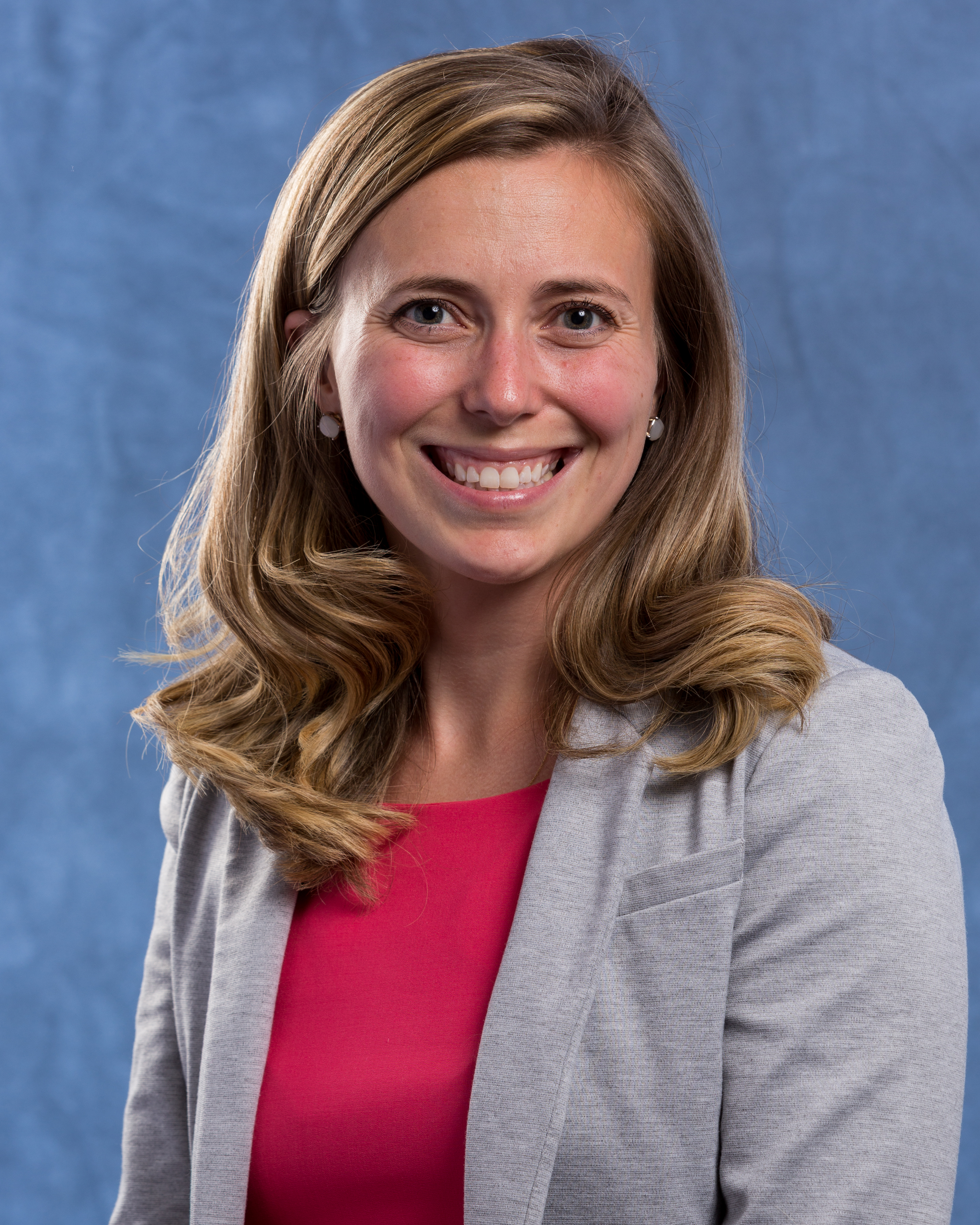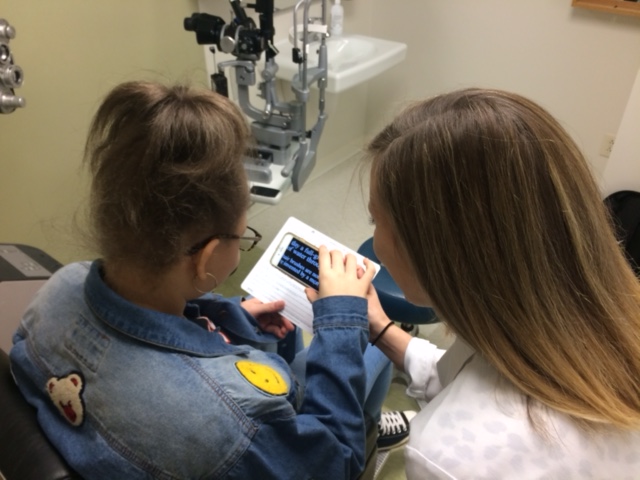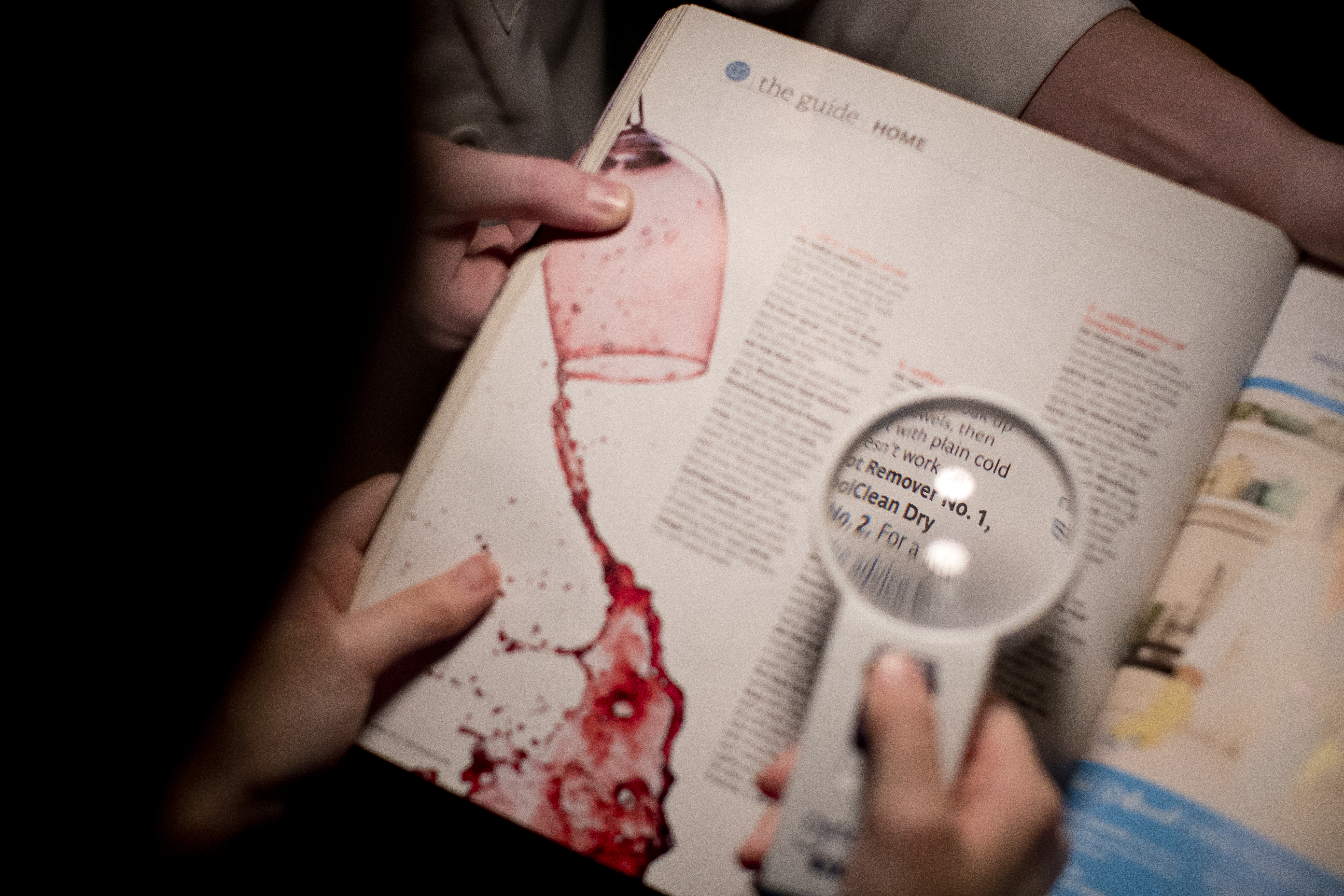In our new podcast series, we will be talking to doctors from The Eye Institute to get an inside look at what goes on behind the scenes and what a typical day in the life is like for a doctor at the clinic. In this episode, we met with Erin Kenny, OD ’15, FAAO, Resident ’16, chief of the William Feinbloom Vision Rehabilitation Center.
 Dr. Kenny:
Dr. Kenny:
Hi, everyone. I'm so excited to be here. My name is Erin Kenny. I am the chief of the William Feinbloom Vision Rehabilitation Center. It is the low vision service that's located at The Eye Institute and then I'm also an assistant professor at Salus University.
Hope Daluisio:
Great, thank you so much for being here today. Can you walk us through what a typical day for you would be like at The Eye Institute?
Dr. Kenny:
Absolutely. So my day, I usually get to The Eye Institute around 8:00 a.m. I review yesterday's patients and today's patients during that time period from 8:00 to 8:30, just get an overlook of what the day is going to look like. Then at 8:30 a.m., we start with a staffing of the entire interdisciplinary team that is a part of the Feinbloom Center. So we have the low vision interns that are on the call for the staffing meeting. We also have the low vision doctors. We have the rehab staff that could consist of a certified low vision therapist, a certified orientation and mobility specialist or an occupational therapist. Then we also have our social workers on the call, as well.
So what we do is we go through that day's patients list. We go through the schedule and we review the different pathologies the patient may have, different issues that they may be having when it comes to things that they would like to accomplish with their goals. Then we also talk about psychosocial aspects that a patient may be experiencing. Finally, we also brainstorm ideas about how to help the patient. I do have to say, I should probably put this out there first, that we are a low vision service. We work with patients who are visually impaired. They come in, it's a very goal-oriented exam. These patients have a visual impairment from several different types of pathologies and we help them accomplish their goals.
These goals may be reading the Bible, or maybe it's seeing the television a little bit better. But it could also be seeing something like seeing the pins down at the end of the bowling alley a little bit clearer, or maybe feeling a little bit more comfortable navigating in their environment. So, like I said, from 8:30 to 9:00 we review the patients. I think that's my favorite part of the day, to tell you the truth, because it's a great way for the interns to hear the other cases that their colleagues are going to be seeing. I think they also like to see our thought process as the low vision doctors or the social workers or the rehab team think of how we're going to handle the exam and attack these complex cases that come through the low vision service. So from 8:30 to 9:00 then that's our staffing.
Then we start seeing patients in the morning and the afternoon. Once again, these cases are complex, but they are rewarding, as well. We see a lot of patients with different pathologies and the intern will get to work with the patient. Then they come back to the doctor and we get to discuss and brainstorm different ways that we can help a patient, that may be with devices, it could be with non-optical options, it could be with appropriate referrals. I would say that pretty much sums up my day from seeing patients in the morning and the afternoon. Usually at the end of the day, we wrap up and review the chart or go over any questions that the students have.

Hope Daluisio:
Would you say that every day is pretty different or do you see a lot of the same type of patients?
Dr. Kenny:
Honestly, I think that's probably the best part of my job, the fact that no day is ever the same as the day before. Even if we see somebody both, maybe I see two patients with macular degeneration, it's always a different kind of exam, whether it's maybe a more severe case of macular degeneration or maybe it's different goals. One patient may be set on seeing the computer a little bit better, or maybe that next patient wants to be able to see their grandkids' faces. Even if it's the same pathology, same age, same demographic, their goals could be completely different. That's what makes it so fun, is you can get to experience a lot of different cases. So I would say it is different from day to day.
Hope Daluisio:
Sounds like it keeps you on your toes, for sure. What is something that you do as a TEI doctor that your patients, or maybe someone on the outside, might not know?
Dr. Kenny:
So there's two things I'd probably want to talk about here. The one thing I've already mentioned is having an interdisciplinary team. I am very lucky because I have rehab specialists and social workers that are housed in the clinic. They're actually on the floor with me. When it comes to maybe grabbing a quick consultation or having a discussion with one of these rehab specialists or the social workers, I get to do that on a daily basis. Where a lot of times other practices may have to refer out or some practices don't even have social workers. So having the ability to interact with interdisciplinary professionals, it's really special because everything is already under one roof. We're able to work together. That'd be one thing I would want people to know. It's not your regular eye exam because there's going to be other specialists and other professionals that are there to help you.
The second thing that I think is pretty cool that we started within the last year is we've started doing genetic screenings. A lot of patients come in and they might have inherited retinal dystrophies or some other inherited ocular pathology. And we're now offering free genetic screenings. That's been helpful and informational to the patient and to the clinician to get some of those results back. It helps us with the management and the discussion with the patient of how we can further help them. So those would be the two things I would want people to be aware of outside the clinic.
Hope Daluisio:
It seems like you get to see lots of different cases, different types of patients. Out of all of the people you see, I'm sure there's a lot, but what is the most rewarding part of your job at The Eye Institute?
Dr. Kenny:
There's this moment sometimes, and I love to experience it with the intern as well, is when you show a device to a patient and they're able to maybe read that print that they have not been able to read in years, and just that moment of pure joy of being able to do something that they haven't been able to do in a very long time. Just yesterday I had a patient. I had asked him, "Is there a photo that you want to see? Is there a photo of someone you haven't seen in a while?" And he said to me, his nephews. So we pulled up his nephews. This is very millennial talk, but we pulled up his nephews on Facebook and we put it underneath the video magnifier and it was able to enlarge the faces large enough that he could identify his nephews. He said he had not seen his nephews in two years. That was the first time that he got to see their faces.
Those are the moments that make working at TEI and working at the William Feinbloom Vision Rehabilitation Center so special, is helping those patients achieve those goals. Sometimes it's heartbreaking because patients will say, "Why did it take so long for someone to refer me to you?" Or, "Why didn't I know that you guys existed?" That's probably the heartbreak of my job, is that sometimes these patients have not been getting the help that they need or they don't realize that low vision exists. But the reward of being able to help those patients makes it all worth it.
Hope Daluisio:
That sounds incredible. I'm sure you get to experience that a lot.
Dr. Kenny:
Yeah. It's a great job. I'm very lucky.
Hope Daluisio:
How do the interns react to that type of stuff? Because I'm sure you've seen it before, but that they might be seeing stuff like that for the first time.
Dr. Kenny:
It's interesting because I feel like that's where a lot of times we have a bonding moment. It's one thing when I teach them or in the course where I'm like, "Okay, a 4X telescope can get somebody from 20/80 to 20/20," and they're doing the math and you're doing the optics behind it. But seeing it in the exam room makes it so real. I think that's where the interns, sometimes it hits home. The light bulb goes on and like, "Oh my gosh, all these optics points, all the discussion of the devices, they actually can help patients." I often like looking at the intern to see their reaction as well, because I feel sometimes the dots are finally connected and they get to see it in real life and on a real person of how we can help them.
Because it's one thing to discuss cases in a course or in a classroom, but to see it happen in real life is really special. Even to this day I still get moved by it. There's times when I'll walk out of the exam room and be a little teary-eyed and I look over at the intern and they're teary-eyed, but it's a really special experience at the Feinbloom Center.

Hope Daluisio:
That's incredible. Is there anything else you'd like to add about your job or the patients you see, anything at all?
Dr. Kenny:
I want people to know that there is no cutoff for visual acuity to be seen in the low vision service. Sometimes people will say, "Well, they're 20/25. That's only one line worse than 20/20. They don't need to go to low vision." But whether it's you or a family member or a friend or just someone that you know that is unable to do something because of their vision, it's worth a call to the Feinbloom Center to see if there's something we can do to help you. People have this misconception that low vision is all about just devices, where it's handheld magnifiers or telescopes, but low vision is so much more.
Everybody's actually walking around with a low vision device in their pocket. Everybody's cell phone could be utilized in a low vision way. There's different ways we can change accessibility options. There's different apps you can download. So being knowledgeable that we do not take into consideration visual acuity or visual field when it comes to seeing a patient or being referred for low vision, it's all about their functional vision. If anybody is ever having any kind of issues, no matter their BA, no matter their visual field, it's worth a call to the Feinbloom Center to see if we can help them. It's not being legally blind or it's not having vision worse than 20/70. You can be having functional issues with 20/25 acuity and being knowledgeable that our service exists for people like that, as well.
Hope Daluisio:
I feel like there's so many different types of ways to just enhance your vision right on your phone. Like you were saying, no one ever realizes that.
Dr. Kenny:
It's really special and I'm going to give a shout out. We have a social worker who works at the Feinbloom Center. Her name is Virginia Scott and she's completely blind. She has no light perception in both eyes. She utilizes her iPhone every day. She has it set up that she can communicate. We text often. She can email. So there is no visual cutoff to being able to use a cell phone. That's why I always say. Probably one of the first questions I ask my patients is, "Do you have a smartphone?" Because there's a lot of things that we can do on that. So just so patients are aware. And even if you know a family member or a friend that you know is having issues or you notice that they're having issues, it's worth a call.
Hope Daluisio:
That's definitely interesting to think about and talk about. And it sounds like you guys are doing great things.
Dr. Kenny:
Thank you. Yes, I'm very proud of my team.
To learn more about The Eye Institute and the Feinbloom Center, specifically, you can visit SalusUhealth.com/TEI. Stay tuned for our next episode, where we'll go behind the scenes with Alissa Coyne, OD ‘10, FAAO, Resident ‘11, staff optometrist: primary care and emergency service at The Eye Institute.